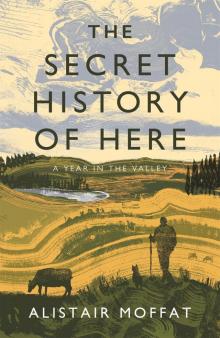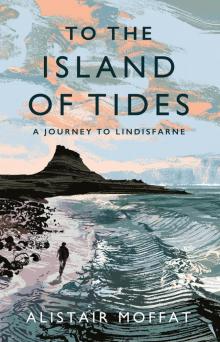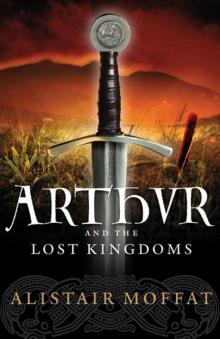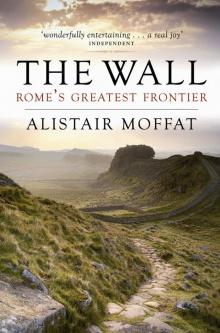- Home
- Alistair Moffat
Britain’s Last Frontier Page 27
Britain’s Last Frontier Read online
Page 27
Much moved by his uncle’s bitter tears and all the loss, MacIver wrote one of the great modern Gaelic lyrics, ‘An Ataireachd Ard ’:
An ataireachd bhuan
Cluinn fuaim na h’ataireachd ard
Tha torann a’ chuain
Mar chualas leam-s’ ’nam phaisd.
Gun mhuthadh, gun truas
A’ sluaisreadh gainneimh na tragh’d
Cluinn fuaim na h’ataireachd ard
The eternal surge of the sea
Listen to the roar of the mighty surge.
The thundering of the ocean is
As I heard it in my childhood,
Without cease, without pity,
Washing over the sands of the shore.
The eternal surge of the sea,
Listen to the roar of the mighty surge.
Sna coilltean a siar,
Chan iarrain fuireach gu brath.
Bha m’intinn ‘s mo mhiann
A riamh air lagan a’ bhaigh.
Ach iadsan bha fial
An gniomh, an caidreamh’s an agh
Air scapadh gun dion
Mar thriallas ealtainn roimh namh . . .
In the woods of the west,
I would not want to wait forever.
My mind and my longing
Were ever in the little hollow by the cove.
But those who were gracious
In action, in friendship and in laughter
Are scattered without protection
Like a flock of birds before an enemy . . .
It is likely in 1851 that the young Domhnall Ban Crosd boarded the Barlow, an emigrant ship that dropped anchor in Loch Roag, not far from Carnish. Sir James Matheson’s factor, Munro Mackenzie, was frustrated at how slowly the four hundred emigrants boarded and he sent an irritated message on to the next port of call in Lewis, telling those in charge ‘to put them on without their luggage’. Not only would that speed up embarkation, it would also leave room where more emigrants could be packed in.
The long transatlantic voyage was often the stuff of nightmares. In the foul and insanitary conditions below deck, disease festered. Smallpox and seasickness were killers and on the ship Hercules, that left from Skye and the Uists bound for Adelaide in Australia, 38 died. A passenger noted, ‘Some of the emigrants are dreadfully sick . . . some of the mothers have had their children in their arms for five days and nights without intermission.’ After 104 days at sea, several very young children arrived as orphans, bewildered, small strangers in a strange land. Some never arrived at all. In the peak years between 1847 and 1853, 49 emigrant ships were lost at sea.
The population of the Highlands declined sharply, especially in the Hebrides and the coastal districts north of the Great Glen, accelerating the conversion of a working landscape into scenery. Between 1847 and 1858, more than 16,000 sailed for the Americas or Australasia, many of them having been forced on to the ships. Sometimes men had to be bound as they were dragged to the quaysides. Written in the 1870s, here is Catherine MacPhee’s recollection of what went on: ‘I have seen the big strong men, the champions of the countryside, the stalwarts of the world, being bound on Lochboisdale quay and cast into the ship as would be done to a batch of horses or cattle in the boat, the bailiffs and the ground-officers and the constables gathered behind them in pursuit of them.’
With the annual arrival of the royal family at Balmoral setting all sorts of trends, the land left idle by the evictions needed a use and so-called sporting estates were quickly established. Where farmers had once grown food for their families, deer were allowed to breed. They were followed by wealthy men with time on their hands and guns in them. By 1884, almost two million acres of Scotland, most of it north of the Highland Line, was given over to deer forests for the amusement of a privileged few.
Those who watched the white-sailed ships slip over western horizons, those left behind to grub a living from a harsh and barren landscape began to resist the tide of history. It had run against them for more than a century. The 1880s saw economic failure in the Highlands with a series of poor harvests and poor catches at sea. Similar conditions in Ireland had prompted rent strikes and, in 1881, the crofters on Skye refused to make payments to their landlords. A year later, resistance threatened to become violent. Sent from Portree to the nearby district of Braes, a sheriff officer carried a sheaf of eviction notices for tenants who had refused to pay rents to Lord Macdonald. He was stopped on the road by the women of Braes and they forced him to burn the notices. Tension quickly escalated. Police officers from Glasgow sailed into Portree to reinforce the Skye constables and soldiers were promised if required. It must have seemed to the crofters that the British establishment, the so-called forces of law and order, were uniting to attack them.
And they did. At what became known as the Battle of the Braes, crofters’ leaders were arrested and subsequently imprisoned. Women took an active part and were driven back by the police. There were many injuries. Widely reported, this incident prompted government action and, for once, it was not of a punitive sort. In Ireland, tenants had begun to arm themselves and more than violent scuffles were to follow. Although it was not tied to nationalism, it was believed that a similar situation might arise in the Highlands and, to forestall it, the government set up a Royal Commission in 1883 to be chaired by Lord Napier.
While evidence was being taken, Highlanders suddenly found their political voice. With the extension of the franchise, five crofter MPs were returned in the general election of 1885 and accounts of injustices and arguments for change found their way into Hansard, becoming a matter of record. Remoteness was no longer a factor that worked in favour of the landlords and allowed them to do as they wished.
The Napier Commission interviewed witnesses from four parishes believed to be representative and, at Farr in Inverness-shire, Duirinish in Skye, Uig in Lewis and Uig in South Uist, they came across many examples of grinding poverty, of people living far below the breadline. This is what the commission reported about the total of 3,226 families living in the four parishes:
Only one tenth are provided with holdings which can afford sustenance to a labouring family. One thousand, seven hundred and seventy eight are in possession of tenancies which imply a divided and desultory form of occupation. At the bottom of the social scale, more than one quarter are without land and without access to local wages.
Side by side with this mingled multitude, so slenderly furnished with the means of life, we find thirty occupiers forming less than one per cent of the whole community in the occupancy of nearly two thirds of the land. These thirty include a factor, a few proprietors and some non-resident tenants.
Legislation was quickly framed. Modelled on the Irish Land Acts of 1870 and 1881, the Crofters’ Holdings (Scotland) Act of 1886 arose directly from the agitation, the findings of the Napier Commission and the presence of crofters’ MPs at Westminster. Prime amongst its measures, security of tenure was granted and it set up the Crofters’ Commission, a land court where disputes could be heard and resolved.
While its great achievement was to remove the summary power of landlords to evict, the act was weak on the resolution of disputed access to land. Agitation continued and what were known as land raids organised. These involved the forced reoccupation of sheep farms and deer forests as common grazing, an attempt to restore rights of access that had been removed for generations.
The Crofters’ Act, however, did lead to the recognition of a significant cultural shift. In defining crofting, as it had to, the act designated Scotland’s crofting counties. These were Shetland, Orkney, Caithness, Sutherland, Ross and Cromarty, Inverness and Argyll. The effect of this was to realign the Highland Line and push it much further north-west. Most of Perthshire and Stirlingshire and the Highland districts of Angus, Aberdeenshire, Banff, Moray and Nairn were no longer seen as part of a crofting culture and their removal also mirrored the shrinking Gaelic speech community.
Less brutal and usually forced only by economi
cs, the emigrations continued into the 20th century. The Metagama and the Marloch were still sailing in the 1920s from Hebridean ports with passengers bound for the New World and a new life. Inevitably departure and loss have deeply coloured Highland history of the last 250 years and it is not a disposition to melancholy and sentiment to state it, but no more than the reality. The great bard of departure was Sorley MacLean and here is Hallaig, his haunting poem for those who have gone.
Farmer’s Boy
John R. Allan wrote two masterpieces. Each focuses on the North-east of Scotland – one is a wide sweep, a survey of the lowland farm country that runs in a coastal strip of varying width from Montrose to Caithness in the north, and the other is a miniature, an account of Allan’s upbringing on a farm near Aberdeen. Farmer’s Boy is beautifully realised and written and it recreates perfectly, with a little licence, the atmosphere of the farm at Dungair before the Second World War brought radical change. Sunlight sparkles and warmth and love animate its all too few pages. And yet John R. Allan’s story began in a very much harsher light. He was rescued by his grandparents from an orphanage where his mother had abandoned him before emigrating to Canada. His compendium of the geography, history and culture of the north-east lowlands is magisterial – and highly opinionated. Written unequivocally from the Lowland side of the Highland Line, it is much more than a guidebook. The attitudes of the 1950s are occasionally precisely distilled: ‘Nothing so annoys a true native of these lowlands than the suggestion that he is a Highlander. Even when it is meant as a compliment – and it always is – we know it as a deadly insult.’ Allan was by no means agin Highlanders but he did deeply, and rightly, suspect those versions of Highland culture such as the National Mod and the growing fetish for Highland dress as ‘a sad case of a large and vibrant dog being wagged by a moribund wee tail’. But, by contrast, he was often tickled by Highland priorities and relished the tale of a level crossing where the road rather than the railway gates were usually shut because trains were more frequent than cars and sheep more frequent than either. John R. Allan loved the North-east with a quiet passion: ‘the care was a sort of religion, perhaps nearer to our hearts than anything the churches can teach’.
Tha tim, am fiadh, an coille Hallaig
Tha buird is tairnean air an uinneag
Troimh’m faca mi an Aird an Iar
’s tha mo gaol aig Allt Hallaig
’na craoibh bheithe, ’s bha i riamh
Time, the deer, is in the wood of Hallaig
The window is nailed and boarded
Through which I saw the West
And my love is at the Burn of Hallaig
A birch tree, and she has always been
Eader an t’Inbhir ’s Poll a’ Bhainne,
Thall ’s a bhos mu Baile-Chuirn:
Tha I ’na beithe, ’na calltuinn,
’na caorunn dhireach sheag uir.
Between Inver and Milk Hollow,
Here and there about Baile-Chuirn:
She is a birch, a hazel,
A straight, slender young rowan.
Ann an Screapadal mo chinnidh
Far robh Tarmad ’s Eachunn Mor,
Tha ’n nigheanan ’s am mic ’nan coille
Ag gabhail suas ro taobh an loin.
In Screapadal of my people
Where Norman and Big Hector were,
Their daughters and sons are a wood
Going up beside the stream.
Uaibhreach a nochd na coilich ghiuthais
Ag gairm air mullach Cnoc an Ra,
Direcah an druim ris a’ ghealaich –
Chan iadsan coille mu ghraidh.
Proud tonight the pine cocks
Crowing on the top of Cnoc an Ra,
Straight their backs in the moonlight –
They are not the wood I love.
Fuirichidh mi ris a’ bheithe
Gus an tig i a mach an Carn,
Gus am bi am bearradh uile
O Bheinn na Lice f’a sgail.
I will wait for the birch wood
Until it comes up by the cairn,
Until the whole ridge from Beinn na Lice
Will be under its shade.
Mura tig ’s ann thearnas mi a Hallaig
A dh’ionnsaigh sabaid na marbh,
Far a bheil an sluagh a’ tathaich,
Gach aon ghinealach a dh’fhalbh.
If it does not, I will go down to Hallaig
To the Sabbath of the dead,
Where the people are frequenting,
Every single generation gone.
Tha iad fhathast ann a Hallaig,
Clann Ghill-Eain ’s Clann MhicLeoid,
Na bh’ann ri linn Mhic Ghille-Chaluim:
Chunnacas na marbh beo.
They are still in Hallaig,
MacLeans and MacLeods,
All who were there in the time of Mac Gille Chaluim:
The dead have been seen alive.
14
The City of the Gael
‘NO,’ SAID PARA HANDY, ‘it iss a low-country song I heard wance in the Broomielaw. Yon iss the place for seeing life. I’m telling you it is Gleska for gaiety if you have the money. There iss more life in wan day in the Broomielaw of Gleska than there is in a fortnight in Loch Fyne.’
‘I daresay there iss,’ said Dougie; ‘no’ coontin’ the herring.’
‘Och! Life, life!’ said the Captain, with a pensive air of ancient memory; ‘Gleska’s the place for it. And the fellows iss there that iss not frightened, I’m telling you.’
‘I learned my tred there,’ mentioned the engineer, who had no accomplishments, and had not contributed anything to the evening’s entertainment, and felt it was time he was shining somehow.
‘Iss that a fact, Macphail? I thocht it wass in a coal-ree in the country,’ said Para Handy. ‘I was chust sayin’, when Macphail put in his oar, that yon’s the place for life. If I had my way of it, the Fital Spark would be going up every day to the Chamaica Brudge the same as the Columba, and I would be stepping ashore quite spruce with my Sunday clothes on, and no’ lying here in a place like Colintraive where there’s no’ even a polisman.’
Captain of the Vital Spark, a Gaelic archetype for the 20th and 21st centuries, Para Handy seems immortal. Very popular, genuinely and enduringly funny, the stories about the little Clyde puffer and its crew first appeared in the Glasgow Evening News in 1905. Continuously in print since then, the tales were made into television first with Duncan MacRae as the skipper, then Roddy McMillan and, most recently, Gregor Fisher. And despite the caricature, Para Handy feels as though he was drawn from a recognisable life, the lost world of seagoing trade between small coastal communities on the Firth of Clyde and the Hebrides beyond. His proper name is Peter MacFarlane and the nickname derives from a Gaelic patronymic. Padraic Shandaidh means Peter, son of Sandy. And his views about Glasgow’s virtues and how dull is remote Colintraive also chime with real experience.
When the Vital Spark slipped her moorings at the Broomielaw and chugged down the Clyde bound for Colintraive, Furnace, Tighnabruaich, Ardrishaig and a dozen other coastal villages with quays and a need for small cargoes of timber, herring boxes or coal, she unknowingly crossed the Highland Boundary Fault. At the hamlet of Craigendoran, a suburb to the south of Helensburgh, it is clearly visible as it crosses the high ground before submerging beneath the Firth of Clyde. Perhaps in a parallel universe, Para Handy might have sounded the Vital Spark’s horn in salute as he steered her past.
Not only was the skipper crossing a geological and cultural frontier, he was also passing the home of his creator. Neil Munro was a distinguished journalist and a great novelist whose reputation now, sadly, rests solely on the exploits of the Vital Spark’s crew. Literary fashion is notoriously capricious and Munro’s more serious work is unjustly neglected. He was innovative, a revisionist in the viewpoints of his historical fiction and a pivotal figure in the changing relationships and perceptions of Highlanders and Lowlanders.
An illegitimate child born in 1863, Munro was raised in a Gaelic-speaking household by his mother and grandmother near Inverary in Argyll. Bilingual by the time he went to school, his ear was always tuned to the nuances of both languages. His rendering of Para Handy’s Gaelicised Lowland Scots is pitch perfect, the eccentric word order a precise translation and the emphases and cadences unfailingly correct. The skipper may have been a larger-than-life character but he always sounded very like the real thing.
After a childhood in Glen Aray and a brief apprenticeship as a clerk in a lawyer’s office, Munro made a journey familiar to thousands of Highlanders. At the age of 17 he found a job as a cashier in an ironmonger’s shop in Glasgow but he seems to have been early set on a career in journalism. Munro’s ambitions were quickly realised and, in only four years, he became chief reporter on the Glasgow Evening News. In the meantime he had found time to court and marry Jessie Adam, the daughter of his landlady in North Woodside Road.
At the time of his marriage Munro will often have heard Gaelic spoken in Glasgow’s streets. The census of 1881 reported 11,000 Gaels and this urban speech community rose to a peak of 18,500 in 1901. Against the background of an expanding population of more than half a million, this may have seemed a tiny island of Gaelic in a sea of English but it was concentrated. North Woodside Road was not far from Partick on the north bank of the Clyde. Immigrant communities often stayed close and tended to nucleate near where they had arrived and, in the case of Partick, that would have been nearby at the Broomielaw.
When significant numbers from the Highlands settled in Glasgow, many of them the victims of forced evictions, they often took the lowliest jobs and occupied some of the worst housing, as often happens with newcomers. In 1846, The Scotsman newspaper sneered, ‘It is a fact that morally and intellectually the Highlanders are an inferior race to the Lowland Saxon.’
And The Baillie, a weekly magazine published in Glasgow, regularly made Highlanders the object of derision. The halting English of ‘Auchtray MacTavish, the Hielan Polisman’ was laughed at. In fact, the city’s police force actively recruited Highlanders, believing them to be big, steady lads not easily riled. And the Clyde Trust, operators of ferries and docks, also favoured men from the Hebrides. Their sea craft was often learned early and well and so many were employed that the ferry services on the Clyde were known as the Skye Navy.

 The Secret History of Here
The Secret History of Here The Night Before Morning
The Night Before Morning To the Island of Tides
To the Island of Tides Arthur and the Lost Kingdoms
Arthur and the Lost Kingdoms Britain’s Last Frontier
Britain’s Last Frontier The Faded Map: The Lost Kingdoms of Scotland
The Faded Map: The Lost Kingdoms of Scotland The Wall
The Wall